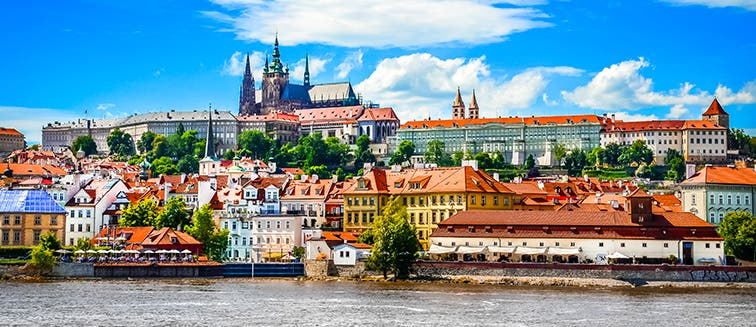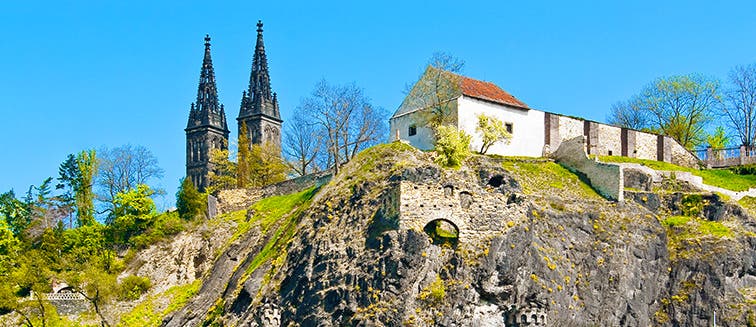The Czech Republic, also known as Czechia, is a Central European nation, rich in history and proudly one of Europe’s most popular travel destinations, in particular, its fascinating, fairy-tale capital of Prague, the focal point of most trips to the Czech Republic. Landlocked between Poland, Slovakia, Austria and Germany, the Czech Republic offers traveler more than just charming chocolate-box cities, but also a chance to peer through the looking glass into the history of Europe as a whole, due to its central location and long, eventful history.
Over the centuries, the Czech Republic has been both a battle-ground and a playground for kingdoms and empires, so many intriguing relics have been left behind. Countless ancient castles, mansions, and monasteries are scattered throughout the country, many of which are set amongst forested countryside and mountains, such as the impressive hilltop castle of Bouzov or the atmospheric ruins of Rabi Castle.
Prague steals the spotlight when it comes to travel to the Czech Republic, but cities such as Brno in the south and the pretty spa resort of Karlovy Vary are not to be missed. Of course, one of the Czech Republic’s best-known features is its unbeatable beer scene. A long history of brewing combined with a forward-thinking artisan beer trend makes it Europe’s best-loved destinations of beer aficionados.
History of the Czech Republic
The Czech Republic, in roughly the same form as we know it today, did not emerge until the 9th-century, with the establishment of the Duchy of Bohemia. Before this time, both Celtic and Germanic tribes and Slavs had inhabited the Central European region. In 921, famous King Wenceslas inherited the throne of Bohemia, converting the kingdom to Christianity. Shortly thereafter, around the beginning of the 11th-century, Bohemia became part of the Holy Roman Empire and continued to play an important role in the region throughout the Middle Ages.
The Golden Age of Bohemia can be said to be the 14th-century when many of its most iconic monuments were founded and Prague flourished as a center of learning and culture. Both the Charles Bridge and Charles Square, must-see sights on a trip to the Czech Republic, were established during this age, as well as Charles University, today the oldest and largest in the country. The long-lived rule of the Holy Roman Empire came to an end in 1806 and Bohemia was integrated into Austria-Hungary.
Following World War I, Czechoslovakia was formed as the Habsburg Empire collapsed, encompassing many different ethnic minorities into one state. This caused a number of struggles within the new state, especially for some of the German population, who desired independence. During World War II, Czechoslovakia was annexed and occupied by Germany, a difficult time in Czech history. As the war came to a close in 1945, almost all of the German population were forcefully expelled beyond Czechslovakia’s borders, just as Czechoslovakia became part of the Soviet Union, under which it remained for the next 41 years.
The so-called Velvet Revolution of 1989 brought a peaceful return to democracy for Czechoslovakia as it severed its ties with the Soviet Union. In 1993 it split into the two separate states of Slovakia and Czech Republic in similarly peaceful circumstances. Ever since this time, the Czech Republic has dedicated itself to integration into world markets and is today part of the European Union and NATO.
Nature in the Czech Republic
Although city breaks to Prague are one of the more popular choices for travel to the Czech Republic, the beauty of this country’s natural attractions cannot be overlooked. Rolling hills, dense forests and green river valleys are just some of the inspiring landscapes that the Czech Republic is known for. A temperate climate ensures pleasantly warm summers and snowy winters. The Czech Republic is home to a number of national parks, perhaps the most famous of which is the Krkonose National Park, a designated biosphere reserve situated on the border with Poland.
The mist-shrouded Krkonose Mountains are encompassed within the park, where you can expect to find alpine landscapes, fine-forests, and fields of powdery snow. Punkva Caves are another must-see natural attraction to discover on a trip to the Czech Republic. This amazing underground cave system has walking trails that allow visitors to discover mighty stalagmites and stalactites as they navigate a fascinating subterranean world. There’s even the chance to take a boat trip on an underground river that weaves through the cave system.
One of the Czech Republic’s most unique natural landscapes is Hruboskalsko, an extraordinary rock formation composed of hundreds of sandstone towers. Daredevils flock to the park to scale these rocks, whilst a spiral staircase allows less-adventurous travelers to climb to the top of Hlacatic Lookout for amazing panoramic views.
Culture of the Czech Republic
Due to the nation’s situation in the heart of Europe, it’s culture has long been shaped by a variety of influences. The official language is, of course, Czech, and Slovak is widely spoken. Although a Slavic-speaking country, the Czech Republic leans towards western Europe in many ways when it comes to culture. Nevertheless, a number of folkloric traditions and customs endure to this day. In South Bohemia and Moravia, folk culture is still alive and celebrated, particularly in the summer months, when traditional clothing is widely worn throughout the festival season.
On a holiday to the Czech Republic, you’re sure to witness singing, dancing, live music and locals adorned in colorful clothing if you’re lucky enough to catch a traditional folklore celebration during your visit. Historically, Czech people have been characterized as tolerant and open-minded, and today the country is considered one of the most secular places in the world, with 75% of its population claiming to be unaffiliated with any faiths.
Of course, part of the Czech Republic’s appeal is its thriving beer culture. The home of modern beer, which was invented in Plzen in 1842, Czech’s drink more beer than any other nation in the world. If you’re enthusiastic to experience true Czech culture during your trip to the Czech Republic, be sure to visit a modest hospoda, a type of traditional bar, where you can order a beer and raise a pint with the locals.
From the fairy-tale streets of historic Prague to the rolling countryside of South Bohemia and the thermal springs of Karlovy Vary, a trip to the Czech Republic is always a good idea, whether you’re a history buff, a city-breaker or a beer aficionado.

















